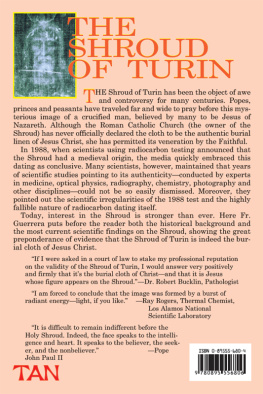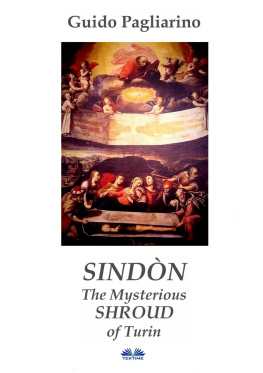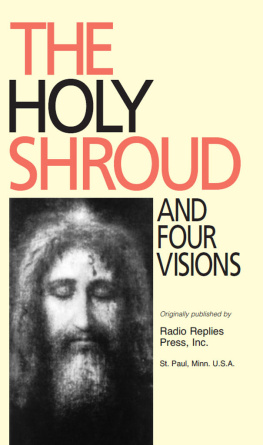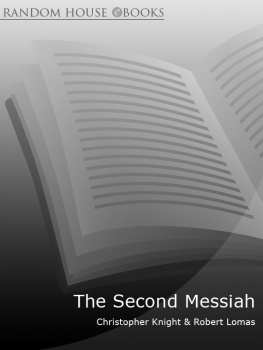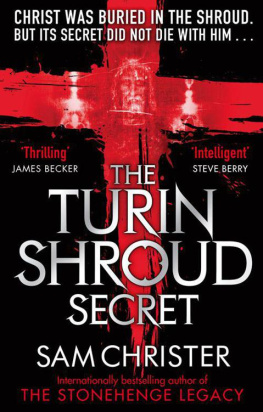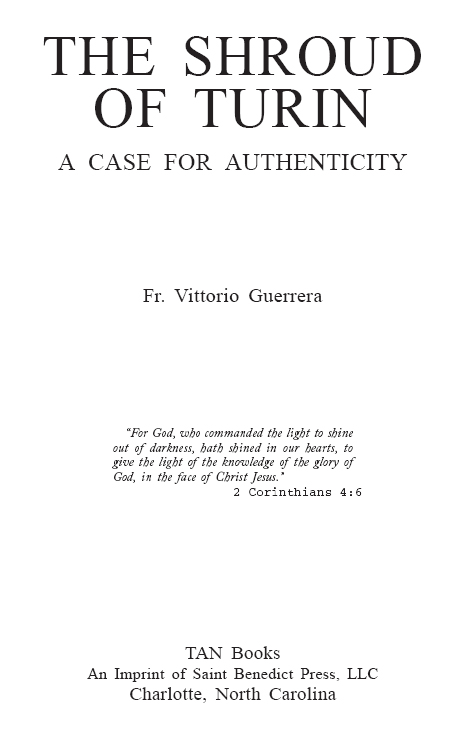
Copyright 2001 by Rev. Vittorio Guerrera
ISBN 0-89555-680-4
Library of Congress Control No. 00-134501
All rights reserved. No part of this book may be reproduced or transmitted in any form or by any means, electronic or mechanical, including photocopying, recording, or by any information storage or retrieval system, without written permission from the publisher, except that brief selections from the text may be copied or quoted for non-profit use without permission.
Cover illustration: The entombment of the body of Christ in the Shroud, by Jean Gaspard Baldoino (1590-1669). Original located in the Chapel of the Holy Shroud, Nice, France. Photo courtesy of Confrrie de la Trs Sainte Trinit/Penitents Rouges de Nice.
Printed and bound in the United States of America.
TAN Books
An Imprint of Saint Benedict Press, LLC
Charlotte, North Carolina
2013
There is no beauty in him, nor comeliness: and we have seen him, and there was no sightliness, that we should be desirous of him. Despised, and the most abject of men, a man of sorrows, and acquainted with infirmity: and his look was as it were hidden and despised, whereupon we esteemed him not. Surely he hath borne our infirmities and carried our sorrows: and we have thought him as it were a leper, and as one struck by God and afflicted. But he was wounded for our iniquities, he was bruised for our sins: the chastisement of our peace was upon him, and by his bruises we are healed.
Isaias 53:2-5
CONTENTS
ACKNOWLEDGMENTS
The author would like to thank the following individuals for their assistance with this book: Evelyn Fracasso, Ph.D., Fr. William Donovan, and Fr. William Henn, O.F.M. Cap., for proofreading the manuscript and for editorial suggestions; Fr. Thomas Buffer, Fr. Hans Hintermaier and Rachel Wisler for their proficiency with foreign languages; Fr. Joseph Marino, O.S.B. and Charles Coretto for bibliographical references; and Jack Orabona for his computer graphic skills.
PREFACE
Peter then came out with the other disciple, and they went toward the tomb. They both ran, but the other disciple outran Peter and reached the tomb first; and stooping to look in, he saw the linen cloths lying there, but he did not go in. Then Simon Peter came, following him, and went into the tomb; he saw the linen cloths lying, and the napkin, which had been on his head, not lying with the linen cloths but rolled up in a place by itself. Then the other disciple, who reached the tomb first, also went in, and he saw and believed.
John 20:3-8
F ROM that day onward, the course of human history changed because of what those disciples saw and believed when they peered into that empty tomb. Even though the Gospels relate that only the linen cloths were present and that the body of Jesus was nowhere to be found, many believe that the disciples saw more than just the burial cloths. They also saw the imprint of the crucified body of Jesus Christ on the Shroud. Ever since that day, the story of the Shrouds travels has been filled with intrigue and legend. Reports of the Shroud or what has been likened to the Shroud have been circulated in Turkey, Constantinople, France, and eventually Italy. The Shroud, which has been preserved in the Cathedral of Turin since 1578, is believed by many to be that very same cloth.
The Shroud has been the object of devotion for many centuries. Popes, princes and peasants have traversed far and wide to pray before this mysterious image. Although the Roman Catholic Church has never officially declared the Shroud of Turin to be the authentic burial cloth of Jesus Christ, she has permitted its veneration by the faithful. The Churchs faith in the Resurrection of Christ does not rest upon the authenticity of the Shroud, but on the witness of the Apostles. As St. Paul teaches, Faith then comes by hearing, and hearing by the word of Christ ( Rom . 10:17).
In 1988, the Church allowed radiocarbon dating to be conducted on the Shroud to obtain an age for the cloth. This test was long awaited by believers and non-believers alike. If the Shroud dated back to the first century, that would uphold its authenticity. If not, non-believers would rejoice that it was a forgery. The test yielded a medieval date. Skeptics were pleased, while believers were dismayed. For some, this datum put to rest the story of the Shroud. However, those who were convinced of the Shrouds authenticity remained undaunted and forged ahead with research. Although the Church has not permitted any further scientific testing of the Shroud to date, independent and interdisciplinary research continues.
In this book I have attempted to unfold the drama of the Shroud. It is my conviction, based upon the evidence presented here, that the Shroud of Turin is the authentic burial cloth of Jesus Christ. While it is beyond the scope of science to identify with certitude the man on the Shroud, I am hopeful that the reader will come to weigh the evidence and decide in favor of this case for authenticity.
THE SHROUD OF TURIN
A CASE FOR AUTHENTICITY
The Lord bless thee, and keep thee. The Lord show his face to thee, and have mercy on thee. The Lord turn his countenance to thee, and give thee peace.
Numbers 6:24-26
History of the Shroud
T HE Shroud of Turin is a linen cloth of ivory color measuring fourteen feet three inches long by three feet seven inches wide or eight cubits long by two cubits wide, according to first-century Jewish measurements. (A cubit is equivalent to 21.7 inches.) The cloth is made of a three-to-one herringbone weave with a Z twist. Parallel to one side of the cloth is sewn a six-inch-wide strip of the same weave pattern. It is generally believed that this piece was added to the Shroud in order to insert a rod to facilitate its exposition. The Shroud bears the frontal and dorsal image of a naked, crucified, bearded man, approximately five feet eleven inches tall, between the ages of 30-35, weighing about 175 pounds. Many people believe that this Shroud is the burial cloth of Jesus Christ.
The history of the Shroud can be traced with assurance to the mid-fourteenth century. Prior to that period, little is known with absolute certainty concerning its whereabouts. A third century Syrian text mentions a cloth that is associated with the miraculous cure of King Abgar V, ruler of Edessa (13-59 A.D.), now called Urfa, in southeastern Turkey. This story was translated almost verbatim by Eusebius, bishop of Caesarea, in his Ecclesiastical History in 325 A.D.
While the Syrian account refers to Thaddeus as one of the seventy-two disciples of the Lord (cf. Luke 10:1), he soon came to be associated with Jude Thaddeus, the apostle who was a cousin of Jesus (cf. Matt . 13:55; Mark 6:3). One of the earliest Byzantine icons to depict Thaddeus holding the Image of Edessa, as the cloth was referred to there, was painted in 550 A.D. and is located at St. Catherine Monastery on Mount Sinai. In the Western tradition, St. Jude is often represented holding an image of the face of Jesus over his heart. It has been suggested by the British historian Ian Wilson that the Image of Edessa was actually the Shroud folded in such a way that only the face was visible. Early replicas of the Image were portrayed as an elongated trellis frame with a circle in the middle that depicted the face. A sixth-century text called The Acts of Thaddeus refers to such an image as a tetradiplon , a Greek word which literally means doubled in four or, put another way,

